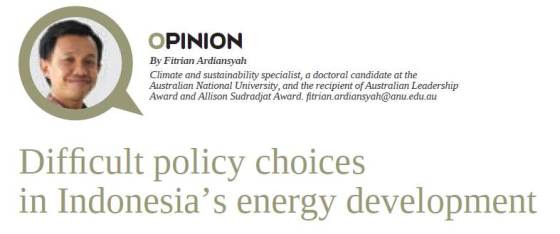Published in COAL ASIA MAGAZINE, VOL. 2, OPINION, AUGUST 17-SEPTEMBER 17, 2012, PAGE 94-95
by Fitrian Ardiansyah
To see the pdf version, please click COALASIA_OPINION_fitrian ardiansyah_energy&forest_Aug2012
As the largest energy producer and consumer in Southeast Asia, Indonesia is currently struggling to cope with the increase in energy demand each year, causing short-term energy shortage and likely leading to worse situation if no immediate actions taken.
Albeit having enormous energy potential, developing energy sources in this country, while desirable, is fraught with hurdles, ranging from regulatory and pricing issues, lack of capacity and investment, to the problematic location of energy sources.
The heavy reliance on subsidized fossil fuels means it has brought about significant problems of energy security and economic issues, especially ever since Indonesia became a net importer of both crude oil and refined products in 2004.
The new extraction of oil, gas and coal as well as the development of new and renewable energy sources has been viewed as a priority by the government but this development faces a number of challenges, such as the fact that some locations of these energy sources overlap with Indonesia’s remaining important and fragile ecosystems, including its forests.
It has been reported by the Forestry Ministry in 2011 that the area of forests within mining concessions, which include for oil, gas and coal activities, covers approximately 2.03 million hectares – based on 842 licenses given for mining related exploration and exploitation between 2005 and 2011.
A number of environmental organizations, such as Mining Watch Canada and Walhi, even claimed a higher number stating that as of 2005, mining activities have encroached on or threatened 11.4 million hectares of forest in Indonesia, including 8.68 million hectares of protection forests and 2.8 million hectares of conservation areas.
A 2008 study conducted in South Kalimantan by M. Handry Imansyah and Luthfy Fatah of Lambung Mangkurat University, published in ASEAN Economic Bulletin, found that a massive coal exploitation without a proper technical handling for reclamation can cause serious water contamination and land degradation, because many mining areas are often left without rehabilitation.
A similar concern may also be said when it comes to the development of renewable energy, namely biofuels and geothermal.
In the case of biofuels development, mainly from palm oil, although considered as one of renewable sources of energy and therefore has the greenhouse gas (GHG) saving potentials, the development of these crops can further increase GHG emissions if the plantation replace forests and peat lands.
A 2011 article written by Gayathri Vaidyanathan in Nature shows that, for example, in North Sumatra and Bengkulu provinces, 38 and 35 percent, respectively, of peat-swamp forest were converted to oil palm plantations by the early 2000s – leading to the release of about 144.6 million tons of carbon from biomass above ground and peat oxidation below ground.
Another study conducted by Lian Pin Koh and David S. Wilcove in 2008, published in Conservation Letters,estimates that over 56 percent of oil palm expansion occurred at the expense of natural forest cover for the period between 1990 and 2005. In addition, according to the 2009 BAPPENAS (National Development Planning Agency) report, as of 2006, plantation licenses (i.e. predominantly for oil palm) on peatlands totalled 1.3 million ha.
With regard to geothermal energy, this type of renewables has a significant potential to contribute to the future electricity generating capability – with 10 gigawatts of total geothermal potential that is presently ready for commercial extraction as reported in 2009 by the World Bank.
If developed appropriately and immediately, geothermal energy can at least reduce the burden of approximately 35 percent of the current total generation capacity in 2035, as argued in a 2012 paper written by a research team from the Christian University of Indonesia, and eventually contribute to climate change mitigation.
Accelerating the development of geothermal energy is likely to be challenging since up to 60 percent of its potentials and reserves are located in the remaining important forest areas, according to a 2009 paper written by Montty Girianna, the Energy, Mineral and Mining Resources Director of Bappenas.
The exploration, extraction and overall activities of oil, gas, coal and geothermal have been previously subjected to the laws regulating the protection and management of pristine forests, including employing stricter conditions under which licenses are to be issued.
A 2011 report by PricewaterhouseCoopers explains that the Forestry Law No. 41 of 1999 (and its amendments No. 1 of 2004 and 19 of 2004) prohibit oil, gas and mining activities in protected forest areas except where a government permit is obtained.
This, however, was gradually altered, particulary since February 2010 when Government Regulation No. 10 of 2010 on Forest Areas Utilization was introduced. According to this regulation, development projects, including oil and gas activities, power plants, mining, transport and renewable energy projects, can take place in protected forests if they are deemed strategically important.
Specifically on geothermal, a presidential decree (No. 28 of 2011) released on 19 May 2011, allows conditional underground mining in protected forest areas, which includes geothermal energy. This decree was later strengthened with the release of the Memorandum of Understanding between the Energy and Mineral Resources Ministry and the Forestry Ministry (No. 7662 of 2011) aiming at accelerating the permit issuance of geothermal energy development in forest areas.
Critics, however, view that these regulations and policies which promote and accelerate energy development in forest areas will also encourage other destructive mining activities to take place since the use of the definition of ‘strategic’ or ‘vital’ development activities can have multiple interpretation.
Furthermore, these critics question the level of seriousness of the Indonesian president’s pledge to reduce Indonesia’s GHG, if many of his government’s policies still incorporate a large number of activities that will lead to deforestation in primary and secondary forests as well as peatlands.
It is, therefore, imperative for Indonesia to find practical and applied solutions to balance energy development and forest protection.
The balanced development of energy and forest protection is also crucial since the pledge made by Indonesia’s President particularly mentioning his commitment to changing the status of Indonesia’s forests from a net-emitter sector to a net-sink sector by 2030 and more specifically, emphasizing the preservation of areas under forest protection as one of key programs.
One immediate step to do this, for example, is by harmonizing and synergizing different regulations and policies that will result in a clearer guidance from the government. Vague words like ‘vital’ or ‘strategic’ development activities need to be clarified so that these will not be used as a loop hole.
Synergyzed policies will not be implementable if data regarding conventional energy sources, renewables and forest areas are not synergized as well. Recent actions taken by a number of government’s institutions to synchronize and agree on a map of forest and land use in Indonesia – adhered to across all sectors and levels of government – are therefore crucial to contribute to balancing energy development and forest protection.
Following these steps, a set of sustainability benchmarks is deemed urgent to be instituted to provide technical directions to mitigate the impacts and risks of energy development on forests.
The sustainability benchmarking – promoting principles of high conservation value forest, effective environmental assessment, management plans and monitoring, and multi-stakeholders participation – is required because not only the actual environmental impacts have to be mitigated but also the perceived risks coming from energy projects on these ecosystems need to be addressed, in which local communities and the public may have substantial interest.
The development and implementation of these benchmarks will also align with other laws regulating forest and biodiversity protection, namely the 2009 Forestry Law, the 1990 Biodiversity Conservation Law and the 2009 Environmental Protection and Management Law.
As an emerging economy with a significant increase in energy demand, supplying energy while reducing environmental impacts is definitely a balancing act.
Finding solutions, as elaborated above, is hence urgently required and if these solutions are applied appropriately, Indonesia is likely to secure its future energy in a sustainable way.
——
Fitrian Ardiansyah
The writer is climate and sustainability specialist, a doctoral candidate at the Australian National University, and the recipient of Australian Leadership Award and Allison Sudradjat Award. He can be reached at fitrian.ardiansyah@anu.edu.au






